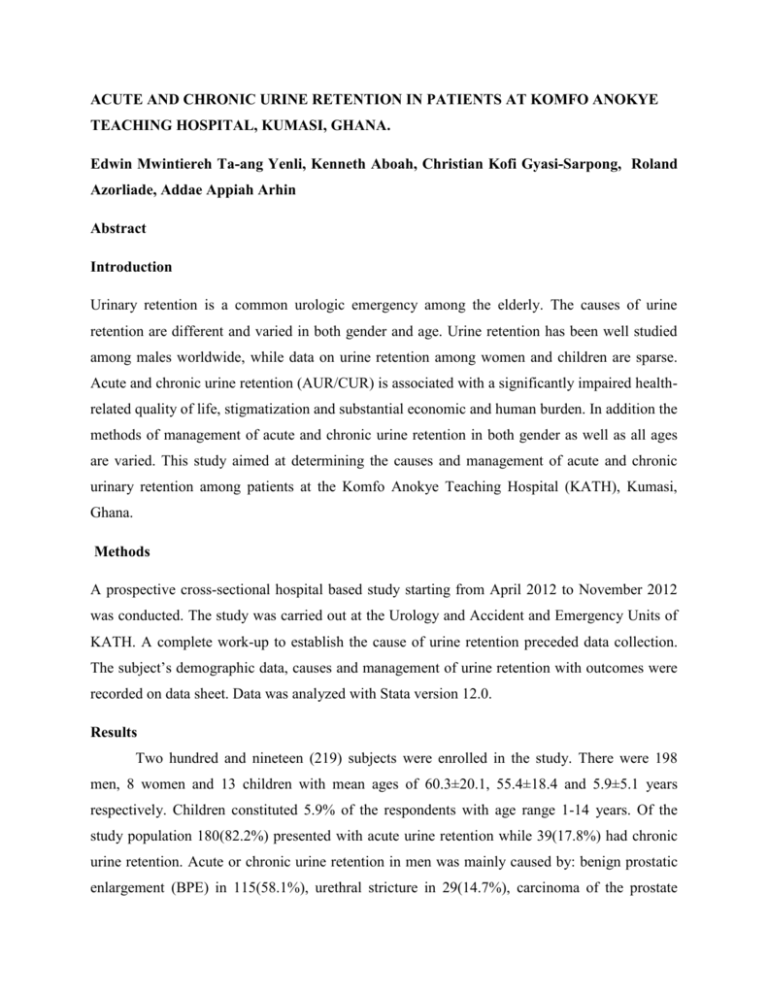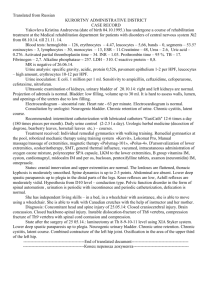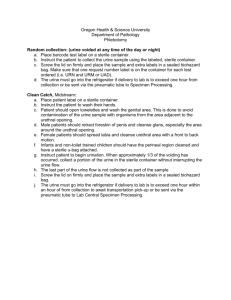Acute and chronic urinary retention
advertisement

ACUTE AND CHRONIC URINE RETENTION IN PATIENTS AT KOMFO ANOKYE TEACHING HOSPITAL, KUMASI, GHANA. Edwin Mwintiereh Ta-ang Yenli, Kenneth Aboah, Christian Kofi Gyasi-Sarpong, Roland Azorliade, Addae Appiah Arhin Abstract Introduction Urinary retention is a common urologic emergency among the elderly. The causes of urine retention are different and varied in both gender and age. Urine retention has been well studied among males worldwide, while data on urine retention among women and children are sparse. Acute and chronic urine retention (AUR/CUR) is associated with a significantly impaired healthrelated quality of life, stigmatization and substantial economic and human burden. In addition the methods of management of acute and chronic urine retention in both gender as well as all ages are varied. This study aimed at determining the causes and management of acute and chronic urinary retention among patients at the Komfo Anokye Teaching Hospital (KATH), Kumasi, Ghana. Methods A prospective cross-sectional hospital based study starting from April 2012 to November 2012 was conducted. The study was carried out at the Urology and Accident and Emergency Units of KATH. A complete work-up to establish the cause of urine retention preceded data collection. The subject’s demographic data, causes and management of urine retention with outcomes were recorded on data sheet. Data was analyzed with Stata version 12.0. Results Two hundred and nineteen (219) subjects were enrolled in the study. There were 198 men, 8 women and 13 children with mean ages of 60.3±20.1, 55.4±18.4 and 5.9±5.1 years respectively. Children constituted 5.9% of the respondents with age range 1-14 years. Of the study population 180(82.2%) presented with acute urine retention while 39(17.8%) had chronic urine retention. Acute or chronic urine retention in men was mainly caused by: benign prostatic enlargement (BPE) in 115(58.1%), urethral stricture in 29(14.7%), carcinoma of the prostate constituted 26(13.1%), traumatic urethral injury was found in 26(13.1%), bladder calculi 1(0.5%) and paraphimosis 1(0.5%). Two subjects representing 0.9% of the total study population and 25% of the women enrolled had bladder cancer. Of the total study population only one patient (0.5%) had utero-vaginal prolapse, representing 12.5% of the women sampled. Likewise, bladder stones as a cause of urine retention in this study was found in 1(12.5%) of women recruited.. The only patient, with urethral tumour was a woman representing 12.5% of the women enrolled in the study. Urethral trauma and neurogenic bladder were also found in 1(12.5%) and 2(25%) women respectively. Among children, posterior urethral valves were 9 representing 69.2% of this group. Two of these children had neurogenic bladder constituting 15.4%. One each of phimosis and bladder calculi was also found among these children. Urinary tract infection occurred in 15.1% and renal insufficiency in 14.2% of respondents. The mean volume of urine drained on catheterization was 300±161.7 ml. The immediate treatment of acute or chronic urine retention was by urethral catheterization in 68.9% and suprapubic cystostomy in 30.2%. Two (0.9%) vesicostomies were performed when neonates were involved. For those with BPE, trial of micturition without catherization was instituted in 15(13.0%) and administration of alpha adrenergic blockers was administered in 34(29.6%). The varied aetiologies required varied treatment modalities such as transurethral resection of the prostate in 1(0.9%), and transversical prostatectomy for BPE in 20(17.4%). Of those with urethral stricture, urethral dilatation was performed in 28(50.9%), urethroplasty in 26(47.3%) and Otis internal urethrotomy in 1(1.8%). For the women, hysterectomy with culdoplasty and anterior vaginal colporrhaphy was performed while bladder stones were removed by open cystolithotomy. The women with bladder cancer and urethral cancer were managed by radiotherapy. Oncological treatment was instituted and was still ongoing for all respondents with cancer disease during and after the study. Among the children, posterior urethral valves were managed with catheter valve avulsion in 2(22.2%), vesicostomy in 2(22.2%), urethral catheterization 3(33.3%) and suprapubic cystostomyin in 2(33.3%). There was no functional endoscopic equipment to institute appropriate endoscopic treatment as such patients requiring treatment with use of such equipment were referred to other centers where this service was available. Open cystolithotomy and circumcision were performed for children with bladder calculi and phimosis respectively. The median waiting time for those requiring surgery was 60 days (interquartile range 14-179 days). Conclusions Acute and chronic urine retention is not uncommon, but credible baseline data on this condition is nonexistent at KATH, Kumasi. Urine retention found among the participants was mainly AUR rather than CUR. Men were the most affected with benign prostatic enlargement, being the leading cause.Among women, acute or chronic urine retention was caused mainly by bladder cancer and neurogenic bladder.Posterior urethral valves was found to be the main cause of urine retention among children presenting to the urology unit of KATH. Initial and definitive management were varied between causes, gender and age.







